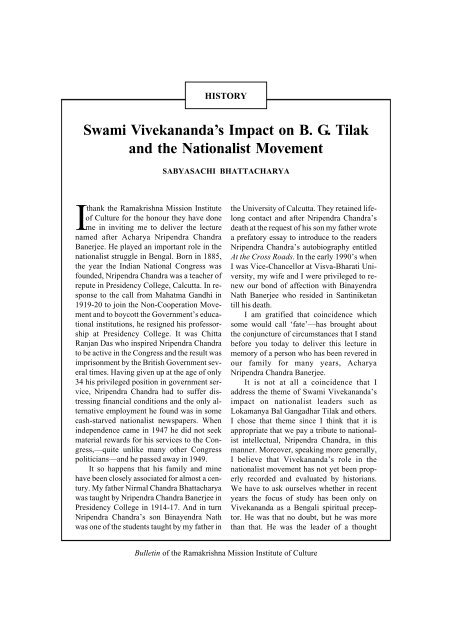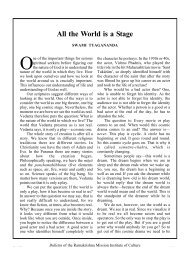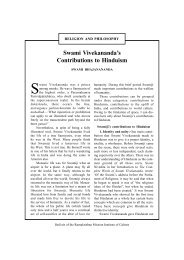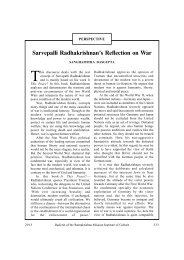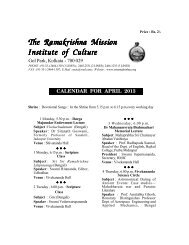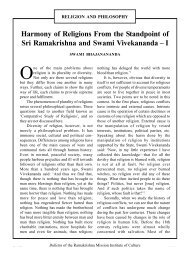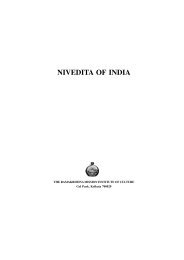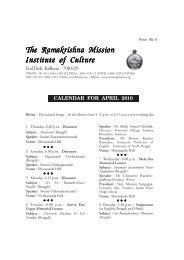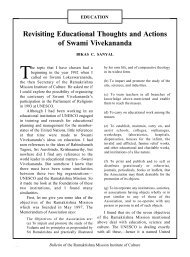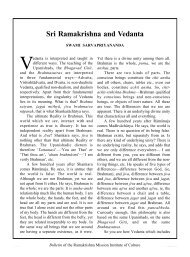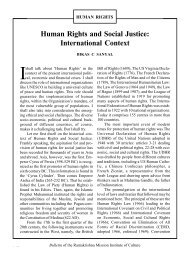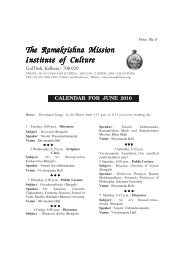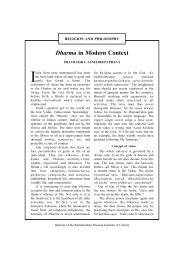Swami Vivekananda's Impact on B. G. Tilak and the Nationalist ...
Swami Vivekananda's Impact on B. G. Tilak and the Nationalist ...
Swami Vivekananda's Impact on B. G. Tilak and the Nationalist ...
You also want an ePaper? Increase the reach of your titles
YUMPU automatically turns print PDFs into web optimized ePapers that Google loves.
SWAMI VIVEKANANDA’S IMPACT ON B. G. TILAK AND<br />
THE NATIONALIST HISTORYMOVEMENT<br />
<str<strong>on</strong>g>Swami</str<strong>on</strong>g> Vivekan<strong>and</strong>a’s <str<strong>on</strong>g>Impact</str<strong>on</strong>g> <strong>on</strong> B. G. <strong>Tilak</strong><br />
<strong>and</strong> <strong>the</strong> Nati<strong>on</strong>alist Movement<br />
SABYASACHI BHATTACHARYA<br />
Ithank <strong>the</strong> Ramakrishna Missi<strong>on</strong> Institute<br />
of Culture for <strong>the</strong> h<strong>on</strong>our <strong>the</strong>y have d<strong>on</strong>e<br />
me in inviting me to deliver <strong>the</strong> lecture<br />
named after Acharya Nripendra Ch<strong>and</strong>ra<br />
Banerjee. He played an important role in <strong>the</strong><br />
nati<strong>on</strong>alist struggle in Bengal. Born in 1885,<br />
<strong>the</strong> year <strong>the</strong> Indian Nati<strong>on</strong>al C<strong>on</strong>gress was<br />
founded, Nripendra Ch<strong>and</strong>ra was a teacher of<br />
repute in Presidency College, Calcutta. In resp<strong>on</strong>se<br />
to <strong>the</strong> call from Mahatma G<strong>and</strong>hi in<br />
1919-20 to join <strong>the</strong> N<strong>on</strong>-Cooperati<strong>on</strong> Movement<br />
<strong>and</strong> to boycott <strong>the</strong> Government’s educati<strong>on</strong>al<br />
instituti<strong>on</strong>s, he resigned his professorship<br />
at Presidency College. It was Chitta<br />
Ranjan Das who inspired Nripendra Ch<strong>and</strong>ra<br />
to be active in <strong>the</strong> C<strong>on</strong>gress <strong>and</strong> <strong>the</strong> result was<br />
impris<strong>on</strong>ment by <strong>the</strong> British Government several<br />
times. Having given up at <strong>the</strong> age of <strong>on</strong>ly<br />
34 his privileged positi<strong>on</strong> in government service,<br />
Nripendra Ch<strong>and</strong>ra had to suffer distressing<br />
financial c<strong>on</strong>diti<strong>on</strong>s <strong>and</strong> <strong>the</strong> <strong>on</strong>ly alternative<br />
employment he found was in some<br />
cash-starved nati<strong>on</strong>alist newspapers. When<br />
independence came in 1947 he did not seek<br />
material rewards for his services to <strong>the</strong> C<strong>on</strong>gress,—quite<br />
unlike many o<strong>the</strong>r C<strong>on</strong>gress<br />
politicians—<strong>and</strong> he passed away in 1949.<br />
It so happens that his family <strong>and</strong> mine<br />
have been closely associated for almost a century.<br />
My fa<strong>the</strong>r Nirmal Ch<strong>and</strong>ra Bhattacharya<br />
was taught by Nripendra Ch<strong>and</strong>ra Banerjee in<br />
Presidency College in 1914-17. And in turn<br />
Nripendra Ch<strong>and</strong>ra’s s<strong>on</strong> Binayendra Nath<br />
was <strong>on</strong>e of <strong>the</strong> students taught by my fa<strong>the</strong>r in<br />
<strong>the</strong> University of Calcutta. They retained lifel<strong>on</strong>g<br />
c<strong>on</strong>tact <strong>and</strong> after Nripendra Ch<strong>and</strong>ra’s<br />
death at <strong>the</strong> request of his s<strong>on</strong> my fa<strong>the</strong>r wrote<br />
a prefatory essay to introduce to <strong>the</strong> readers<br />
Nripendra Ch<strong>and</strong>ra’s autobiography entitled<br />
At <strong>the</strong> Cross Roads. In <strong>the</strong> early 1990’s when<br />
I was Vice-Chancellor at Visva-Bharati University,<br />
my wife <strong>and</strong> I were privileged to renew<br />
our b<strong>on</strong>d of affecti<strong>on</strong> with Binayendra<br />
Nath Banerjee who resided in Santiniketan<br />
till his death.<br />
I am gratified that coincidence which<br />
some would call ‘fate’—has brought about<br />
<strong>the</strong> c<strong>on</strong>juncture of circumstances that I st<strong>and</strong><br />
before you today to deliver this lecture in<br />
memory of a pers<strong>on</strong> who has been revered in<br />
our family for many years, Acharya<br />
Nripendra Ch<strong>and</strong>ra Banerjee.<br />
It is not at all a coincidence that I<br />
address <strong>the</strong> <strong>the</strong>me of <str<strong>on</strong>g>Swami</str<strong>on</strong>g> Vivekan<strong>and</strong>a’s<br />
impact <strong>on</strong> nati<strong>on</strong>alist leaders such as<br />
Lokamanya Bal Gangadhar <strong>Tilak</strong> <strong>and</strong> o<strong>the</strong>rs.<br />
I chose that <strong>the</strong>me since I think that it is<br />
appropriate that we pay a tribute to nati<strong>on</strong>alist<br />
intellectual, Nripendra Ch<strong>and</strong>ra, in this<br />
manner. Moreover, speaking more generally,<br />
I believe that Vivekan<strong>and</strong>a’s role in <strong>the</strong><br />
nati<strong>on</strong>alist movement has not yet been properly<br />
recorded <strong>and</strong> evaluated by historians.<br />
We have to ask ourselves whe<strong>the</strong>r in recent<br />
years <strong>the</strong> focus of study has been <strong>on</strong>ly <strong>on</strong><br />
Vivekan<strong>and</strong>a as a Bengali spiritual preceptor.<br />
He was that no doubt, but he was more<br />
than that. He was <strong>the</strong> leader of a thought<br />
2010 Bulletin of <strong>the</strong> Ramakrishna Missi<strong>on</strong> Institute of Culture<br />
363
SABYASACHI BHATTACHARYA<br />
movement which had an impact <strong>on</strong> all parts written at Marga<strong>on</strong>, Maharashtra, in 1893.<br />
of India. I hope to address that <strong>the</strong>me in my To get back to <strong>Tilak</strong>’s story, he writes:<br />
research <strong>and</strong> in a series of lectures.<br />
At home he would often talk about Advaita<br />
I will begin with <strong>the</strong> story of <strong>Tilak</strong>’s c<strong>on</strong>tact<br />
with Vivekan<strong>and</strong>a. Bal Gangadhar <strong>Tilak</strong> avoided mixing with society. There was ab-<br />
philosophy <strong>and</strong> Vedanta. The <str<strong>on</strong>g>Swami</str<strong>on</strong>g><br />
(1857-1920) was senior to Vivekan<strong>and</strong>a by solutely no m<strong>on</strong>ey with him. A deerskin, <strong>on</strong>e<br />
half a dozen years <strong>and</strong> at <strong>the</strong>ir first encounter or two clo<strong>the</strong>s <strong>and</strong> a kam<strong>and</strong>alu were his<br />
in Bombay in 1892, <strong>Tilak</strong> was quite unaware <strong>on</strong>ly possessi<strong>on</strong>s. In his travels some <strong>on</strong>e<br />
of <strong>the</strong> momentous importance of that meeting.<br />
As you probably know, Vivekan<strong>and</strong>a, in sired stati<strong>on</strong>. The swami also believed like<br />
would provide a railway ticket for <strong>the</strong> de-<br />
pursuit of his plan to travel all over India up<br />
me that <strong>the</strong> Shrimad Bhagavad Gita did not<br />
preach renunciati<strong>on</strong> but urged every <strong>on</strong>e to<br />
to Cape Comorin as a mendicant, passed<br />
work unattached <strong>and</strong> without <strong>the</strong> desire for<br />
through many parts of Maharashtra. In April<br />
fruits of <strong>the</strong> work.<br />
to September 1892 he visited Bombay,<br />
Mahabaleswar, Pune, Kolhapur, Belgaum, We may specially note this particular<br />
<strong>and</strong> Indore. Some of <strong>the</strong> letters Vivekan<strong>and</strong>a statement of <strong>Tilak</strong>’s. The idea of highlighting<br />
<strong>the</strong> c<strong>on</strong>cept of Karma Yoga in <strong>the</strong> Gità<br />
wrote in 1892 provide a sketchy idea of his<br />
itinerary. These letters have been collected in figures very prominently in <strong>Tilak</strong>’s commentary<br />
Gità Rahasya. Vivekan<strong>and</strong>a likewise<br />
The Complete Works of <str<strong>on</strong>g>Swami</str<strong>on</strong>g> Vivekan<strong>and</strong>a,<br />
vol. VIII. 1 This was at a time when he was emphasized Karma Yoga <strong>and</strong> often quoted<br />
not yet famous. Fame came to him next year from <strong>the</strong> Gità <strong>the</strong> well-known verse, kaivalya<br />
when he went to <strong>the</strong> Parliament of Religi<strong>on</strong>s màsma gamah Pàrtha.... He thought that<br />
in Chicago in 1893. In 1892 he was a little ‘in this <strong>on</strong>e shloka lies embedded <strong>the</strong> whole<br />
known sannyasi, hosted by various local message of <strong>the</strong> Gità.’ 3 As Frank Rhodehamel<br />
l<strong>and</strong>lords <strong>and</strong> this picture comes out clearly <strong>and</strong> Sister Nivedita have recorded in <strong>the</strong>ir<br />
in <strong>the</strong> reminiscences <strong>Tilak</strong> recorded in January<br />
1934 in Vedanta Kesari.<br />
held <strong>the</strong> Gità text as <strong>the</strong> New Testament for<br />
notes <strong>on</strong> his ‘Gita class’, Vivekan<strong>and</strong>a up-<br />
<strong>the</strong> Hindus. 4<br />
About <strong>the</strong> year 1892, i.e., before <strong>the</strong> famous<br />
<strong>Tilak</strong> also writes in his memoirs:<br />
Parliament of Religi<strong>on</strong>s in <strong>the</strong> World’s Fair<br />
at Chicago, I was <strong>on</strong>ce returning from Two or three years <strong>the</strong>reafter <str<strong>on</strong>g>Swami</str<strong>on</strong>g><br />
Bombay to Po<strong>on</strong>a. At <strong>the</strong> Victoria Terminus Vivekan<strong>and</strong>a returned to India with worldwide<br />
fame owing to his gr<strong>and</strong> success at <strong>the</strong><br />
a Sannyasin entered <strong>the</strong> carriage I was in. A<br />
few Gujarati gentlemen were <strong>the</strong>re to see Parliament of Religi<strong>on</strong>s <strong>and</strong> also after that<br />
him off. They made <strong>the</strong> formal introducti<strong>on</strong> both in Engl<strong>and</strong> <strong>and</strong> America. He received<br />
<strong>and</strong> asked <strong>the</strong> Sannyasin to reside at my an address wherever he went <strong>and</strong> <strong>on</strong> every<br />
house during his stay at Po<strong>on</strong>a. We reached <strong>on</strong>e of such occasi<strong>on</strong>s he made a thrilling<br />
Po<strong>on</strong>a, <strong>and</strong> <strong>the</strong> Sannyasin remained with me reply. I happened to see his likeness in some<br />
for eight or ten days. When asked about his of <strong>the</strong> newspapers, <strong>and</strong> from <strong>the</strong> similarity of<br />
name he <strong>on</strong>ly said he was a Sannyasin.<br />
features I thought that <strong>the</strong> <str<strong>on</strong>g>Swami</str<strong>on</strong>g> who had<br />
resided at my house must have been <strong>the</strong><br />
Vivekan<strong>and</strong>a seemed to be keen at that<br />
same. I wrote to him accordingly inquiring if<br />
time to be an<strong>on</strong>ymous. Incidentally, at this my inference was correct <strong>and</strong> requesting him<br />
time Vivekan<strong>and</strong>a sometimes used ano<strong>the</strong>r to kindly pay a visit to Po<strong>on</strong>a <strong>on</strong> his way to<br />
name, Sacchidan<strong>and</strong>a. There is at least <strong>on</strong>e Calcutta. I received a fervent reply in which<br />
document signed by him under that name 2 <strong>the</strong> <str<strong>on</strong>g>Swami</str<strong>on</strong>g> frankly admitted that he was <strong>the</strong><br />
364 Bulletin of <strong>the</strong> Ramakrishna Missi<strong>on</strong> Institute of Culture<br />
August
SWAMI VIVEKANANDA’S IMPACT ON B. G. TILAK AND<br />
THE NATIONALIST MOVEMENT<br />
same Sannyasin <strong>and</strong> expressed his regret at<br />
not being able to visit Po<strong>on</strong>a <strong>the</strong>n.<br />
This lost letter from Vivekan<strong>and</strong>a to<br />
<strong>Tilak</strong> must have been written between 1896<br />
<strong>and</strong> 1899, <strong>the</strong> period between his two visits<br />
to USA. <strong>Tilak</strong> says that police search in his<br />
home led to <strong>the</strong> destructi<strong>on</strong> of this letter from<br />
Vivekan<strong>and</strong>a. The last c<strong>on</strong>tact between <strong>Tilak</strong><br />
<strong>and</strong> Vivekan<strong>and</strong>a took place in 1901.<br />
‘During <strong>on</strong>e of <strong>the</strong> C<strong>on</strong>gress sessi<strong>on</strong>s at<br />
Calcutta’, <strong>Tilak</strong> recalls, ‘I had g<strong>on</strong>e with<br />
some friends to see <strong>the</strong> Belur Math of <strong>the</strong><br />
Ram[a]krishna Missi<strong>on</strong>. There <str<strong>on</strong>g>Swami</str<strong>on</strong>g><br />
Vivekan<strong>and</strong>a received us very cordially. In<br />
<strong>the</strong> course of <strong>the</strong> c<strong>on</strong>versati<strong>on</strong> <str<strong>on</strong>g>Swami</str<strong>on</strong>g>ji happened<br />
to remark somewhat in a jocular spirit<br />
that it would be better if I renounced <strong>the</strong><br />
world <strong>and</strong> took up his work in Bengal while<br />
he would go <strong>and</strong> c<strong>on</strong>tinue <strong>the</strong> same in<br />
Maharashtra. “One does not carry,” he said,<br />
“<strong>the</strong> same influence in <strong>on</strong>e’s own province as<br />
in a distant <strong>on</strong>e.”’ 5<br />
<strong>Tilak</strong>’s meeting with Vivekan<strong>and</strong>a<br />
<strong>Tilak</strong> says this meeting with<br />
Vivekan<strong>and</strong>a took place during a C<strong>on</strong>gress<br />
sessi<strong>on</strong> in Calcutta without menti<strong>on</strong>ing a<br />
date. Now, <strong>the</strong>re were two such sessi<strong>on</strong>s in<br />
Calcutta, <strong>on</strong>e in 1896 <strong>and</strong> <strong>the</strong> o<strong>the</strong>r is 1901.<br />
My guess is that <strong>Tilak</strong> met Vivekan<strong>and</strong>a<br />
during <strong>the</strong> 1901 Calcutta sessi<strong>on</strong> of <strong>the</strong><br />
C<strong>on</strong>gress because I infer from dates of his<br />
letter that during <strong>the</strong> earlier sessi<strong>on</strong> of 1896<br />
Vivekan<strong>and</strong>a was out of Calcutta.<br />
To sum it up, from <strong>the</strong> time when<br />
Vivekan<strong>and</strong>a was an unknown itinerant<br />
sannyasin in 1892, till 1901, <strong>the</strong> year before<br />
his death, <strong>Tilak</strong> had fleeting c<strong>on</strong>tacts with<br />
him. The relati<strong>on</strong>ship between <strong>the</strong>se two<br />
thinkers was more in <strong>the</strong> domain of ideas<br />
than its terms of pers<strong>on</strong>al c<strong>on</strong>tacts <strong>and</strong><br />
c<strong>on</strong>versati<strong>on</strong>. No letter between <strong>the</strong>m has<br />
survived. <strong>Tilak</strong>’s name does appear in<br />
Vivekan<strong>and</strong>a’s corresp<strong>on</strong>dence occasi<strong>on</strong>ally,<br />
when he recommended to his disciples<br />
<strong>Tilak</strong>’s publicati<strong>on</strong>s. In <strong>on</strong>e such letter<br />
Vivekan<strong>and</strong>a menti<strong>on</strong>s <strong>Tilak</strong>’s historical<br />
work, Ori<strong>on</strong>, <strong>on</strong> <strong>the</strong> origins of <strong>the</strong> Aryans.<br />
But Vivekan<strong>and</strong>a did not accept <strong>Tilak</strong>’s<br />
speculati<strong>on</strong>s <strong>and</strong> seems to say that <strong>the</strong> facts<br />
are uncertain <strong>and</strong> in any event how did it<br />
matter in history where Aryans came from?<br />
In many towns which Vivekan<strong>and</strong>a had<br />
visited in Maratha country in course of time<br />
social groups were formed to study his writings,<br />
eventually leading to foundati<strong>on</strong> of<br />
ashrams. <str<strong>on</strong>g>Swami</str<strong>on</strong>g> Saradan<strong>and</strong>a, senior m<strong>on</strong>k<br />
in <strong>the</strong> Missi<strong>on</strong>, visited Bombay Province several<br />
times from 1920 to 1930. In 1927 <strong>the</strong><br />
Vivekan<strong>and</strong>a Society was set up in Pune <strong>and</strong><br />
in course of time 25 such societies came up<br />
all over <strong>the</strong> province. After <strong>Tilak</strong> introduced<br />
Ganapati worship <strong>and</strong> Shivaji festival<br />
increasingly <strong>the</strong> political <strong>and</strong> <strong>the</strong> cultural<br />
elements merged. On <strong>the</strong> o<strong>the</strong>r h<strong>and</strong>,<br />
Vivekan<strong>and</strong>a study remained generally apolitical.<br />
Needless to say, <strong>on</strong>e can see both<br />
resemblances <strong>and</strong> differences between <strong>Tilak</strong>s<br />
approach <strong>and</strong> Vivekan<strong>and</strong>a’s ideas.<br />
At this point let us note <strong>the</strong> evidence we<br />
have about <strong>the</strong> extremist nati<strong>on</strong>alists who<br />
were attracted to Vivekan<strong>and</strong>a. <strong>Tilak</strong> was, it<br />
is well known, <strong>on</strong>e of <strong>the</strong> leaders of <strong>the</strong><br />
extremist secti<strong>on</strong> of <strong>the</strong> C<strong>on</strong>gress who<br />
rejected <strong>the</strong> path of c<strong>on</strong>stituti<strong>on</strong>al negotiati<strong>on</strong><br />
with <strong>the</strong> British Indian government. The distance<br />
between <strong>the</strong>se extremist nati<strong>on</strong>alists<br />
<strong>and</strong> <strong>the</strong> militant nati<strong>on</strong>alists, often called<br />
‘terrorists’, was not great. The links between<br />
<strong>the</strong> C<strong>on</strong>gress extremists, <strong>the</strong> militant nati<strong>on</strong>alists,<br />
<strong>and</strong> <strong>the</strong> followers of Vivekan<strong>and</strong>a<br />
was <strong>the</strong> subject of many police investigati<strong>on</strong>s.<br />
New light has been thrown <strong>on</strong> <strong>the</strong><br />
subject recently with <strong>the</strong> publicati<strong>on</strong> of<br />
secret police reports.<br />
Initially, in early part of <strong>the</strong> 20th century<br />
mainly <strong>the</strong> militant nati<strong>on</strong>alists were<br />
attracted by <strong>the</strong> ideology of Vivekan<strong>and</strong>a.<br />
2010 Bulletin of <strong>the</strong> Ramakrishna Missi<strong>on</strong> Institute of Culture<br />
365
SABYASACHI BHATTACHARYA<br />
The most important police report we have is<br />
that by a well-known officer called Charles<br />
Teggart, <strong>the</strong> Superintendent of Police in <strong>the</strong><br />
Intelligence Branch, <strong>and</strong> later <strong>the</strong> Commissi<strong>on</strong>er<br />
of Police in Calcutta. Teggart wrote a<br />
very detailed report covering almost fifty<br />
closely printed pages in 1914. This report<br />
was based <strong>on</strong> reports of police informers or<br />
spies as well as routine reports lodged with<br />
<strong>the</strong> authorities by <strong>the</strong> regular police force in<br />
different parts of India. This report of 1914<br />
has been published recently by <strong>the</strong> Government<br />
of West Bengal, as part of a series of<br />
documents in six volumes edited by <strong>the</strong><br />
Director of Intelligence Branch of West Bengal<br />
Police. 6<br />
What are <strong>the</strong> new facts revealed in <strong>the</strong> IB<br />
or Intelligence Branch reports? First,<br />
R K Missi<strong>on</strong> establishments were sometimes<br />
nodal points in <strong>the</strong> organizati<strong>on</strong> of c<strong>on</strong>spiracies<br />
leading to political crimes by nati<strong>on</strong>alists<br />
in different part of India. Sec<strong>on</strong>dly, many<br />
militants, or so-called terrorists, were as individuals<br />
associated with <strong>the</strong> R K Missi<strong>on</strong><br />
ashrams <strong>and</strong> occasi<strong>on</strong>ally took shelter <strong>the</strong>re.<br />
Thirdly, <strong>the</strong> published works of Vivekan<strong>and</strong>a<br />
<strong>and</strong> generally his message to <strong>the</strong> youth<br />
formed a part of <strong>the</strong> syllabus for training<br />
militants or so-called terrorists.<br />
As regards <strong>the</strong> big c<strong>on</strong>spiracy cases, we<br />
might note that in <strong>the</strong> famous Lahore C<strong>on</strong>spiracy,<br />
Rashbehari Bose as well as accused<br />
five Bengali youths were members of <strong>the</strong><br />
R K Missi<strong>on</strong> branch in Hardwar-Kankhal. 7<br />
Similarly <strong>the</strong> police reports say that in <strong>the</strong><br />
Barisal C<strong>on</strong>spiracy case of 1913, which led<br />
to transportati<strong>on</strong> for life for 12 people, <strong>the</strong><br />
c<strong>on</strong>spiracy was under <strong>the</strong> cover of R K Missi<strong>on</strong>.<br />
The members of Dhaka Anushilan<br />
Samiti regularly used <strong>the</strong> name of missi<strong>on</strong><br />
as a code word for Anushilan Samiti <strong>and</strong> <strong>the</strong><br />
Missi<strong>on</strong> or Vivekan<strong>and</strong>a’s name was a password<br />
for mutual recogniti<strong>on</strong>. 8 According to<br />
ano<strong>the</strong>r report, R K Missi<strong>on</strong> ashram in<br />
Madras was a major base of a secret society.<br />
But this was a report from a police spy <strong>and</strong><br />
cannot be trusted without corroborative evidence.<br />
9 Of <strong>the</strong> Maniktalla C<strong>on</strong>spiracy case,<br />
at least accused Prajnan<strong>and</strong>a also known as<br />
Debabrata Basu, as well as Upendra Nath<br />
Banerjee were c<strong>on</strong>nected with Mayavati<br />
Ashram at Almora. However, Aurobindo<br />
Ghosh of that c<strong>on</strong>spiracy case was not so<br />
c<strong>on</strong>nected with <strong>the</strong> Missi<strong>on</strong>, although he<br />
openly acknowledged that he was profoundly<br />
influenced by Vivekan<strong>and</strong>a’s<br />
ideas. 10 Teggart also alleges link between<br />
Belur Math <strong>and</strong> <strong>the</strong> c<strong>on</strong>spirators of<br />
Maniktalla Bomb c<strong>on</strong>spiracy 11 as well as<br />
c<strong>on</strong>necti<strong>on</strong>s between Mayavati Ashram <strong>and</strong><br />
‘Ram Ch<strong>and</strong>ra Prabhu of Bombay who<br />
harboured some of <strong>the</strong> Bengal anarchists.’<br />
As regards militants or terrorists seeking<br />
shelter in R K Missi<strong>on</strong> as individuals, <strong>the</strong>y<br />
are too numerous to menti<strong>on</strong>. Some were just<br />
occasi<strong>on</strong>al visitors like Jatin Mukherjee or<br />
Pulin Das. The more regular frequenters or<br />
residents were of two categories: probati<strong>on</strong>ers<br />
who left <strong>the</strong> ashram having been w<strong>on</strong><br />
over by militants; sec<strong>on</strong>d, former militants<br />
who joined <strong>the</strong> Missi<strong>on</strong> later in life.<br />
Teggart’s report is incomplete in this regard<br />
because he had little data about ashrams at a<br />
distance from Bengal, e.g. those at Mylapore<br />
in Madras, in Bangalore, in Benares, in<br />
Allahabad etc. At <strong>the</strong> time of Teggart’s<br />
report in April 1914 <strong>the</strong>re were 10 such<br />
out-stati<strong>on</strong>s officially affiliated.<br />
The third set of facts reported by police<br />
in 1914 was regarding <strong>the</strong> use of books by<br />
Vivekan<strong>and</strong>a for training militant nati<strong>on</strong>alists.<br />
The most illustrious example was<br />
Aurobindo Ghosh who highlighted<br />
Vivekan<strong>and</strong>a’s message in his book Bhavani<br />
M<strong>and</strong>ir (Baroda, 1904). The trial of<br />
Anushilan Samiti members revealed that<br />
Vivekan<strong>and</strong>a’s books were ‘Anushilan text<br />
books’ 12 ; militants set up ‘Vivekan<strong>and</strong>a<br />
366 Bulletin of <strong>the</strong> Ramakrishna Missi<strong>on</strong> Institute of Culture<br />
August
SWAMI VIVEKANANDA’S IMPACT ON B. G. TILAK AND<br />
THE NATIONALIST MOVEMENT<br />
Library’ 13 , <strong>and</strong> as <strong>the</strong> police report says,<br />
‘Members of <strong>the</strong> revoluti<strong>on</strong>ary party seized<br />
up<strong>on</strong> <strong>the</strong> teachings of Vivekan<strong>and</strong>a <str<strong>on</strong>g>Swami</str<strong>on</strong>g><br />
<strong>and</strong> adopted <strong>the</strong>m to suit <strong>the</strong>ir own ends.’ 14 In<br />
fact, by <strong>the</strong> time <strong>the</strong> Chittag<strong>on</strong>g Armoury<br />
Raid took place, <strong>the</strong> police regarded possessi<strong>on</strong><br />
of books written by Vivekan<strong>and</strong>a as sufficient<br />
evidence of militant tendency am<strong>on</strong>g<br />
people <strong>the</strong>y arrested; possessi<strong>on</strong> of An<strong>and</strong>a<br />
Math or <strong>the</strong> s<strong>on</strong>g ‘V<strong>and</strong>e Mataram’ was of<br />
course even more reprehensible.<br />
I have used a lot of informati<strong>on</strong> from <strong>the</strong><br />
Intelligence Branch report of 1914 for two<br />
reas<strong>on</strong>s. One reas<strong>on</strong> is that <strong>the</strong>se facts are<br />
new <strong>and</strong> relatively unknown since <strong>the</strong> secret<br />
police reports have been de-classified <strong>and</strong><br />
published <strong>on</strong>ly recently. Sec<strong>on</strong>dly, I wanted<br />
to make <strong>the</strong> point that regardless of<br />
Vivekan<strong>and</strong>a’s views, <strong>the</strong>re were links<br />
between <strong>the</strong> militant nati<strong>on</strong>alists <strong>and</strong> some<br />
members of <strong>the</strong> R K Missi<strong>on</strong> ashrams. This<br />
was true up to around 1914. In later years <strong>the</strong><br />
nati<strong>on</strong>alist movement as a whole came under<br />
<strong>the</strong> spell of Vivekan<strong>and</strong>a’s ideas, <strong>the</strong> erstwhile<br />
Moderates included. But that will be<br />
<strong>the</strong> subject of ano<strong>the</strong>r lecture later, it is not<br />
<strong>the</strong> subject of discussi<strong>on</strong> today since our focus<br />
is <strong>on</strong> <strong>Tilak</strong> <strong>and</strong> <strong>the</strong> extremists.<br />
Vivekan<strong>and</strong>a <strong>and</strong> <strong>the</strong> nati<strong>on</strong>alists<br />
Let us now turn to <strong>the</strong> questi<strong>on</strong>, why<br />
Vivekan<strong>and</strong>a’s ideas influenced <strong>the</strong> nati<strong>on</strong>alists,<br />
first <strong>the</strong> militants <strong>and</strong> <strong>the</strong>n almost all<br />
o<strong>the</strong>rs in <strong>the</strong> nati<strong>on</strong>alist fold? It is not easy to<br />
answer that questi<strong>on</strong>. If you recall <strong>the</strong> fact<br />
that <strong>the</strong>re are more than 5000 pages of<br />
Vivekan<strong>and</strong>a’s thoughts in <strong>the</strong> nine volumes<br />
of his Complete Works, you will realize that<br />
<strong>the</strong> answer to that questi<strong>on</strong> could last l<strong>on</strong>ger<br />
than <strong>the</strong> listeners’ patience.<br />
If we try <strong>and</strong> get to <strong>the</strong> bottom line, what<br />
were <strong>the</strong> reas<strong>on</strong>s that Vivekan<strong>and</strong>a’s ideas<br />
res<strong>on</strong>ated in <strong>the</strong> nati<strong>on</strong>alist mind? First, <strong>the</strong><br />
political struggle for freedom had as a<br />
subtext a cultural struggle. Recovery of.<br />
Indian people’s cultural c<strong>on</strong>fidence, <strong>the</strong>ir<br />
c<strong>on</strong>fidence about <strong>the</strong>ir old civilizati<strong>on</strong> was<br />
important. Vivekan<strong>and</strong>a was <strong>on</strong>e of those<br />
who forcefully presented India’s civilizatio<br />
as something her people can be proud of.<br />
Sec<strong>on</strong>d, talk about India’s ancient culture<br />
<strong>and</strong> civilizati<strong>on</strong> often led, in <strong>the</strong> nati<strong>on</strong>alist<br />
discourse, to a blind glorificati<strong>on</strong> of <strong>the</strong> past.<br />
Vivekan<strong>and</strong>a was keenly aware that to be<br />
proud of <strong>the</strong> past is <strong>on</strong>e thing <strong>and</strong> to live in<br />
<strong>the</strong> past is quite ano<strong>the</strong>r. That awareness was<br />
<strong>the</strong> door to modernity without losing Indian<br />
identity. Thirdly, Vivekan<strong>and</strong>a’s emphasis<br />
<strong>on</strong> unity of <strong>the</strong> Indian people despite difference<br />
in religious beliefs, caste status, class<br />
hierarchy, <strong>and</strong> linguistic <strong>and</strong> cultural differences,<br />
struck a chord comm<strong>on</strong> in all truly<br />
nati<strong>on</strong>alist thought. Finally, Vivekan<strong>and</strong>a<br />
cast a spell <strong>on</strong> nati<strong>on</strong>alist minds in recommending<br />
to <strong>the</strong> youth in particular fearless<br />
engagement in acti<strong>on</strong>. His message of ‘practical<br />
Vedantism’, a philosophy of Karma<br />
Yoga, <strong>and</strong> ‘abhih’ or ‘abhaya’ mantra<br />
appealed to almost all nati<strong>on</strong>alists though<br />
<strong>the</strong>y were doctrinally divided.<br />
(1) As regards <strong>the</strong> first of those ideas, let<br />
us recall <strong>the</strong> circumstances which required a<br />
proud affirmati<strong>on</strong> of Indianness. The nineteenth<br />
century was an era characterized by<br />
increasing distance between advanced West<br />
<strong>and</strong> <strong>the</strong> backward East, <strong>the</strong> denigrati<strong>on</strong> of<br />
Indian civilizati<strong>on</strong> by James Mill <strong>and</strong> o<strong>the</strong>r<br />
‘Orientalists’, <strong>the</strong> demoralizing defeat of <strong>the</strong><br />
uprising of 1857 in north India, <strong>the</strong> abject<br />
dependence of <strong>the</strong> Bengali middle classes <strong>on</strong><br />
<strong>the</strong> jobs <strong>the</strong> British al<strong>on</strong>e could offer, <strong>the</strong><br />
devaluati<strong>on</strong> of indigenous knowledge systems<br />
<strong>and</strong> culture <strong>on</strong> <strong>the</strong> <strong>on</strong>e h<strong>and</strong> <strong>and</strong> <strong>the</strong><br />
growing hegem<strong>on</strong>y of European civilizati<strong>on</strong><br />
<strong>on</strong> <strong>the</strong> o<strong>the</strong>r. The self-esteem of <strong>the</strong> Indian<br />
educated middle classes was at its lowest ebb<br />
by <strong>the</strong> end of <strong>the</strong> century. In <strong>the</strong>se<br />
circumstances Vivekan<strong>and</strong>a comes <strong>and</strong><br />
2010 Bulletin of <strong>the</strong> Ramakrishna Missi<strong>on</strong> Institute of Culture<br />
367
SABYASACHI BHATTACHARYA<br />
affirms <strong>the</strong> greatness of India’s ancient<br />
civilizati<strong>on</strong>. It was a turning-point in diminishing<br />
<strong>the</strong> native Indians’ sense of inferiority,<br />
it was a step towards <strong>the</strong> recovery of an entire<br />
people’s self-c<strong>on</strong>fidence. Vivekan<strong>and</strong>a<br />
struck that note of cultural self-asserti<strong>on</strong><br />
right from 1893. His speeches at <strong>the</strong> Chicago<br />
Parliament of Religi<strong>on</strong>s w<strong>on</strong> over India for<br />
that reas<strong>on</strong> above all o<strong>the</strong>rs. In <strong>the</strong> c<strong>on</strong>cluding<br />
sessi<strong>on</strong> of <strong>the</strong> Parliament of Religi<strong>on</strong>s,<br />
<strong>the</strong> last speech delivered by Vivekan<strong>and</strong>a<br />
emphasized an asserti<strong>on</strong> of equality of all<br />
religi<strong>on</strong>s, in <strong>the</strong> face of <strong>the</strong> assumed superiority<br />
of <strong>the</strong> Christian Church whose representatives<br />
naturally outnumbered all o<strong>the</strong>rs<br />
in <strong>the</strong> Chicago assembly. Parliament of Religi<strong>on</strong>s,<br />
he said, ‘proved to <strong>the</strong> world that holiness,<br />
purity <strong>and</strong> charity are not exclusive<br />
possessi<strong>on</strong>s of any Church in <strong>the</strong> world’. 15<br />
This asserti<strong>on</strong> of equality may have been<br />
made in <strong>the</strong> spiritual domain, but it also carried<br />
ano<strong>the</strong>r message to Indians who read of<br />
<strong>the</strong> triumphs of a Hindu in <strong>the</strong> West. C<strong>on</strong>sider<br />
some reacti<strong>on</strong>s to that news in Indian<br />
newspapers. ‘We can’t become a great nati<strong>on</strong><br />
unless we love our religi<strong>on</strong> <strong>and</strong> try to respect<br />
ourselves . . . . Hindus have at present degenerated.<br />
They have forgotten <strong>the</strong>ir own selfrespect’.<br />
16 ‘There is not a Hindoo who is not<br />
proud of Vivekan<strong>and</strong>a <str<strong>on</strong>g>Swami</str<strong>on</strong>g>. He has d<strong>on</strong>e<br />
h<strong>on</strong>our to himself, to his race <strong>and</strong> religi<strong>on</strong>’. 17<br />
‘The advent of <strong>the</strong> <str<strong>on</strong>g>Swami</str<strong>on</strong>g>ji in <strong>the</strong> West has<br />
undoubtedly enhanced <strong>the</strong> character of <strong>the</strong><br />
Indians in <strong>the</strong> West’. 18<br />
There was an ir<strong>on</strong>y in <strong>the</strong> fact that<br />
Vivekan<strong>and</strong>a was recognised by fellow-Indians<br />
because he was recognised as a preceptor<br />
in <strong>the</strong> West. He was aware of that ir<strong>on</strong>y <strong>and</strong><br />
made fun of it, a sign of his intellectual superiority.<br />
For instance, in his jocular speech<br />
introducing a recent Indian sojourner<br />
in <strong>the</strong> West, he recalls <strong>the</strong> discovery of<br />
America <strong>and</strong> goes <strong>on</strong> to say that in his times<br />
‘multitudes came to America for getting<br />
<strong>the</strong>mselves discovered in <strong>the</strong> United<br />
States’. 19 In this ir<strong>on</strong>ical reference to himself<br />
<strong>and</strong> o<strong>the</strong>rs ‘discovered’ like him,<br />
Vivekan<strong>and</strong>a shows c<strong>on</strong>tempt for <strong>the</strong> trifling<br />
publicity occasi<strong>on</strong>ed by his recepti<strong>on</strong> in <strong>the</strong><br />
West. However, <strong>the</strong>re is no doubt that c<strong>on</strong>temporary<br />
newspapers show that <strong>the</strong> advent<br />
of Vivekan<strong>and</strong>a, hailed as <strong>the</strong> representative<br />
of India, was balm to <strong>the</strong> injured pride of his<br />
countrymen. The <strong>the</strong>me of enhanced ‘selfrespect’<br />
figured prominently in Indian public<br />
opini<strong>on</strong> reflected in reports of <strong>the</strong> kind I have<br />
cited. The lasting effect of Vivekan<strong>and</strong>a’s<br />
message was to elevate Indian culture <strong>and</strong><br />
civilizati<strong>on</strong> in <strong>the</strong> percepti<strong>on</strong> of <strong>the</strong> educated<br />
middle classes.<br />
An oft-quoted passage <strong>on</strong> <strong>the</strong> subject is<br />
<strong>the</strong> perorati<strong>on</strong> at <strong>the</strong> end of an essay <strong>on</strong><br />
‘Modern India’, originally written in<br />
Bengali: ‘Thou brave <strong>on</strong>e, be bold, take<br />
courage, be proud that thou art an Indian,<br />
<strong>and</strong> proudly proclaim, “I am an Indian, every<br />
Indian is my bro<strong>the</strong>r.” Say “The ignorant Indian,<br />
<strong>the</strong> poor <strong>and</strong> destitute Indian, <strong>the</strong> Brahmin<br />
Indian, <strong>the</strong> Pariah Indian, is my<br />
bro<strong>the</strong>r”.’ 20 Here <strong>the</strong> idea of pride in identity<br />
is as important as <strong>the</strong> idea of unity.<br />
The effort we see in Vivekan<strong>and</strong>a to<br />
combine pride in India’s past with a readiness<br />
to embrace modernity, is stated by him<br />
repeatedly <strong>and</strong> clearly. Jawaharlal Nehru<br />
wrote in The Discovery of India:<br />
‘Vivekan<strong>and</strong>a himself was careful to warn<br />
his people not to dwell too much <strong>on</strong> <strong>the</strong> past,<br />
but to look to <strong>the</strong> future. “When, O Lord”, he<br />
wrote, “shall our l<strong>and</strong> be free from this eternal<br />
dwelling up<strong>on</strong> <strong>the</strong> past?”. . . . This looking<br />
back to <strong>the</strong> past <strong>and</strong> finding comfort <strong>and</strong><br />
sustenance <strong>the</strong>re was helped by a<br />
renewed study of ancient literature <strong>and</strong><br />
history. . . .’ As a modernizer, Nehru was<br />
naturally anxious to bring out this trait in<br />
Vivekan<strong>and</strong>a. This was indeed a characteristic<br />
of Vivekan<strong>and</strong>a, marking him out from<br />
368 Bulletin of <strong>the</strong> Ramakrishna Missi<strong>on</strong> Institute of Culture<br />
August
SWAMI VIVEKANANDA’S IMPACT ON B. G. TILAK AND<br />
THE NATIONALIST MOVEMENT<br />
scores of spiritual preceptors of <strong>the</strong> early<br />
twentieth century. For example, in March<br />
1899, in his l<strong>on</strong>g essay of almost fifty pages<br />
<strong>on</strong> ‘Modern India’: “Have we not. . . to learn<br />
anything from <strong>the</strong> West? . . . Are we perfect?<br />
Is our society entirely spotless, without any<br />
flaw? . . . Yes, learn we must many things<br />
from <strong>the</strong> West.’ 22 At <strong>the</strong> same time he<br />
pointed to a dilemma. ‘On <strong>on</strong>e side is<br />
modern Western science, dazzling <strong>the</strong> eyes<br />
with <strong>the</strong> brilliancy of myriad suns. . . <strong>on</strong> <strong>the</strong><br />
o<strong>the</strong>r h<strong>and</strong> are <strong>the</strong> hopeful <strong>and</strong> streng<strong>the</strong>ning<br />
traditi<strong>on</strong>s of ancient forefa<strong>the</strong>rs, in <strong>the</strong> days<br />
when she was at <strong>the</strong> zenith of her<br />
glory. . . .’ 23 The Western civilizati<strong>on</strong> also<br />
was far from being perfect. Moreover, learning<br />
from <strong>the</strong> West should not be mere imitati<strong>on</strong><br />
of <strong>the</strong> West <strong>and</strong> alienati<strong>on</strong> from <strong>on</strong>e’s<br />
own people. Thus he recommended that Indians,<br />
from <strong>the</strong> highest to <strong>the</strong> lowest, should<br />
retain <strong>the</strong>ir identity <strong>and</strong> sense of bel<strong>on</strong>ging<br />
<strong>and</strong>, at <strong>the</strong> same time, be ready to learn what<br />
is worthwhile from <strong>the</strong> West.<br />
Appreciati<strong>on</strong> of Western civilizati<strong>on</strong><br />
There are numerous examples of<br />
Vivekan<strong>and</strong>a’s appreciati<strong>on</strong> of Western civilizati<strong>on</strong><br />
<strong>and</strong> <strong>the</strong> dilemma he analyzed in <strong>the</strong><br />
essay cited above seems to come out of his<br />
own life experiences. In c<strong>on</strong>ceding that India<br />
should learn from <strong>the</strong> West, Vivekan<strong>and</strong>a<br />
differs from <strong>the</strong> c<strong>on</strong>servative Hindu thinkers<br />
<strong>and</strong> in this matter he st<strong>and</strong>s closer to<br />
Rabindranath Tagore. In a tract called ‘The<br />
East <strong>and</strong> <strong>the</strong> West’ 24 Vivekan<strong>and</strong>a reiterates:<br />
‘We have many things to learn from o<strong>the</strong>r<br />
nati<strong>on</strong>s. . . .The nati<strong>on</strong> that says it knows<br />
everything is <strong>on</strong> <strong>the</strong> brink of destructi<strong>on</strong>. . . .<br />
But <strong>on</strong>e point to note here is that when<br />
we take anything from o<strong>the</strong>rs, we must<br />
mould it after our own way. . . . we must<br />
always be careful to keep intact what is<br />
essentially our own.’ 25<br />
(3) It is well known that <strong>the</strong>re were<br />
am<strong>on</strong>g Indian nati<strong>on</strong>alists a secti<strong>on</strong> which<br />
equated a religious community with <strong>the</strong><br />
nati<strong>on</strong>. In thus attributing to a community<br />
nati<strong>on</strong>hood, <strong>the</strong> o<strong>the</strong>r communities were ipso<br />
facto excluded. Thus <strong>the</strong>ir approach was<br />
exclusivist. They may be characterized as<br />
‘religious nati<strong>on</strong>alists’. However, <strong>the</strong> problem<br />
is that <strong>the</strong>re is an ambiguity about that<br />
word ‘religious nati<strong>on</strong>alism’. In <strong>the</strong> language<br />
of those who equate a religious community<br />
with a nati<strong>on</strong> e.g. a ‘Hindu nati<strong>on</strong>’ or a ‘Muslim<br />
nati<strong>on</strong>’—religi<strong>on</strong>, as <strong>the</strong>y underst<strong>and</strong> it,<br />
figures prominently. But that does not mean<br />
that all those who talk of religi<strong>on</strong> <strong>and</strong> of<br />
nati<strong>on</strong>alism are <strong>the</strong>refore ‘religious nati<strong>on</strong>alists’.<br />
That is a fallacy which comes from<br />
c<strong>on</strong>fused thinking. The fallacy c<strong>on</strong>sists of inverting<br />
<strong>the</strong> propositi<strong>on</strong> ‘All religious nati<strong>on</strong>alists<br />
talk of religi<strong>on</strong>’, to read ‘All who talk<br />
of religi<strong>on</strong> are religious nati<strong>on</strong>alists’.<br />
This <strong>the</strong>oretical point needs to be<br />
grasped to underst<strong>and</strong> Vivekan<strong>and</strong>a’s approach<br />
to <strong>the</strong> idea of nati<strong>on</strong>hood which was<br />
far from being exclusive. He made that clear<br />
<strong>on</strong> many occasi<strong>on</strong>s. It is historians who have<br />
made this issue obscure. For instance, since<br />
<strong>the</strong> Missi<strong>on</strong>ary historian Rev. J. N.<br />
Farquahar down to our times many historians<br />
have described Vivekan<strong>and</strong>a as <strong>on</strong>e of <strong>the</strong><br />
creators of ‘Religious Nati<strong>on</strong>alism’. While<br />
supposedly radical historians characterize<br />
him as a Hindu nati<strong>on</strong>alist, from <strong>the</strong> opposite<br />
end of <strong>the</strong> political spectrum, authors like<br />
Eknath Ranade have claimed that he gave ‘A<br />
Rousing Call to Hindu Nati<strong>on</strong>’. Professor<br />
Hiren Mukerjee in a lecture at this Institute<br />
in 1985 said: Vivekan<strong>and</strong>a ‘knew, as Marx<br />
did, that men cannot make history as <strong>the</strong>y<br />
please, but in building <strong>the</strong> future had to use<br />
bricks left by <strong>the</strong> past’. In his view, <strong>the</strong>refore,<br />
it is ‘totally unfair to label Vivekan<strong>and</strong>a’s<br />
work as Religious Nati<strong>on</strong>alism’. 26 A careful<br />
study of Vivekan<strong>and</strong>a’s writings seems to<br />
lend support to Hiren Mukerjee’s views.<br />
2010 Bulletin of <strong>the</strong> Ramakrishna Missi<strong>on</strong> Institute of Culture<br />
369
SABYASACHI BHATTACHARYA<br />
Admittedly, <strong>the</strong>re are indeed some passages<br />
in Vivekan<strong>and</strong>a’ s writings where he speaks<br />
of <strong>the</strong> need to find <strong>the</strong> comm<strong>on</strong> bases of Hinduism<br />
<strong>and</strong> awaken <strong>the</strong> nati<strong>on</strong>al c<strong>on</strong>sciousness<br />
am<strong>on</strong>g Hindus. 27 But <strong>on</strong>e or two such<br />
rare passages (usually occurring in<br />
Addresses to meetings of a Hindu associati<strong>on</strong><br />
or local community) are insignificant<br />
compared to <strong>the</strong> vast number of <strong>the</strong> c<strong>on</strong>trary<br />
kind where he emphasizes <strong>the</strong> unity of all<br />
religi<strong>on</strong>s. Here is a typical passage: ‘. . .<strong>the</strong><br />
religi<strong>on</strong>s of <strong>the</strong> world are not c<strong>on</strong>tradictory<br />
or antag<strong>on</strong>istic. They are various phases of<br />
<strong>on</strong>e eternal religi<strong>on</strong>. . . . Therefore we must<br />
respect all religi<strong>on</strong>s. . . . Religi<strong>on</strong> is realizati<strong>on</strong>:<br />
but mere talk—mere trying to believe,.<br />
. . mere parroting <strong>the</strong> words of ancestors<br />
<strong>and</strong> thinking it is religi<strong>on</strong>, mere making<br />
a political something out of <strong>the</strong> truths of<br />
religi<strong>on</strong>—is not religi<strong>on</strong> at all.’ 28 Or, again,<br />
c<strong>on</strong>sider his statement at <strong>the</strong> Parliament of<br />
Religi<strong>on</strong>s <strong>on</strong> 19 September, 1893: Mankind<br />
needs a universal religi<strong>on</strong> ‘which will not be<br />
Brahminic, or Buddhistic, Christian or<br />
Muhammedan, but <strong>the</strong> sum total of all<br />
<strong>the</strong>se.’ 29 I will not elaborate this point fur<strong>the</strong>r<br />
since many scholars have written about it.<br />
(I may particularly menti<strong>on</strong> <strong>the</strong> latest, <str<strong>on</strong>g>Swami</str<strong>on</strong>g><br />
Prabhan<strong>and</strong>a, ‘Prospect of Human Unity<br />
through Sri Ramakrishna’s Harm<strong>on</strong>y of Religi<strong>on</strong>s’.<br />
30 The unifying ideal cutting across<br />
religious divisi<strong>on</strong>s became a major plank of<br />
<strong>the</strong> nati<strong>on</strong>alist movement as we all know.<br />
(4) Finally, ano<strong>the</strong>r b<strong>on</strong>d between<br />
Vivekan<strong>and</strong>a’s ideas <strong>and</strong> <strong>the</strong> nati<strong>on</strong>alists was<br />
his message of activism, as opposed to a<br />
traditi<strong>on</strong> of religious quietism. That was <strong>the</strong><br />
essence of his ‘Practical Vedanta’, his<br />
exhortati<strong>on</strong> to <strong>the</strong> youth to forget religi<strong>on</strong><br />
limited to <strong>the</strong> cooking pot <strong>and</strong> ‘d<strong>on</strong>ttouchism’,<br />
his effort to remind his countrymen<br />
of <strong>the</strong> message of ‘abhih’ or fearlessness,<br />
<strong>the</strong> exhortati<strong>on</strong> to develop manliness<br />
because ‘you will be nearer to Heaven<br />
through football than through <strong>the</strong> study of<br />
<strong>the</strong> Gita.’ 31 The militant Nati<strong>on</strong>alists in Bengal<br />
particularly were attracted by such ideas<br />
<strong>and</strong> <strong>the</strong>ir famous Liberty Pamphlet reproduced<br />
<strong>the</strong>se stirring words: ‘Let us proclaim<br />
to every soul: “Arise, awake, <strong>and</strong> stop not till<br />
your goal is reached. . . . Too much of inactivity,<br />
too much of weakness, too much of<br />
hypnotism, has been <strong>and</strong> is up<strong>on</strong> our race.”’<br />
Difference between <strong>Tilak</strong> <strong>and</strong><br />
Vivekan<strong>and</strong>a<br />
To sum up, while <strong>the</strong>re is no doubt that<br />
<strong>the</strong> Bengal militants or revoluti<strong>on</strong>aries<br />
(biplabi in c<strong>on</strong>temporary usage) were influenced<br />
by <strong>the</strong> ideas of Vivekan<strong>and</strong>a, it is an<br />
open questi<strong>on</strong> whe<strong>the</strong>r Lokamanya <strong>Tilak</strong> <strong>and</strong><br />
<str<strong>on</strong>g>Swami</str<strong>on</strong>g> Vivekan<strong>and</strong>a influenced each o<strong>the</strong>r<br />
or <strong>the</strong>re were parallel developments in <strong>the</strong>ir<br />
ideas in respect of some issues. The difference<br />
between <strong>Tilak</strong>’s system of ideas <strong>and</strong><br />
that of Vivekan<strong>and</strong>a is fairly obvious. The<br />
most important difference was that<br />
Vivekan<strong>and</strong>a nurtured an inclusive noti<strong>on</strong> of<br />
<strong>the</strong> Indian nati<strong>on</strong> whereas <strong>Tilak</strong>, it is generally<br />
believed, gave centrality to a ‘Hindu nati<strong>on</strong>’<br />
which did not include o<strong>the</strong>r religious<br />
communities. This trend of thinking in <strong>Tilak</strong><br />
was made visible in <strong>the</strong> public sphere in his<br />
cultural strategy, <strong>the</strong> creati<strong>on</strong> of Ganapati<br />
<strong>and</strong> Shivaji festivals. Vivekan<strong>and</strong>a derived<br />
from his spiritual mentor Ramakrishna a<br />
faith in <strong>the</strong> inner unity of <strong>the</strong> essentials of all<br />
religi<strong>on</strong>s <strong>and</strong> hence a broad catholicity open<br />
to all religi<strong>on</strong>s; in Ramakrishna this<br />
approach was a pers<strong>on</strong>al <strong>and</strong> interior realizati<strong>on</strong>,<br />
in Vivekan<strong>and</strong>a it is exteriorized in <strong>the</strong><br />
public sphere, in his discourses <strong>and</strong> writings<br />
harping up<strong>on</strong> <strong>the</strong> need for unity cutting<br />
across religious divides.<br />
While that was a prominent point of<br />
divergence between <strong>Tilak</strong> <strong>and</strong> Vivekan<strong>and</strong>a,<br />
<strong>on</strong>e can see a parallelism in respect of<br />
Vivekan<strong>and</strong>a’s <strong>and</strong> <strong>Tilak</strong>’s ideas in <strong>on</strong>e vital<br />
370 Bulletin of <strong>the</strong> Ramakrishna Missi<strong>on</strong> Institute of Culture<br />
August
SWAMI VIVEKANANDA’S IMPACT ON B. G. TILAK AND<br />
THE NATIONALIST MOVEMENT<br />
area, <strong>the</strong>ir approach to what both of <strong>the</strong>m<br />
called ‘Practical Vedanta.’ This c<strong>on</strong>cept appears<br />
in 1908 in <strong>Tilak</strong>’s well-known book,<br />
Gita Bhasya. 32 ‘No <strong>on</strong>e can expect providence<br />
to protect <strong>on</strong>e who sits with folded<br />
arms <strong>and</strong> throws his burden <strong>on</strong> o<strong>the</strong>rs. God<br />
does not help <strong>the</strong> indolent. . . . Karma Yoga<br />
does not look up<strong>on</strong> this world as nothing, it<br />
requires <strong>on</strong>ly that your motives should be untainted<br />
by selfish interest <strong>and</strong> passi<strong>on</strong>. This is<br />
<strong>the</strong> true view of Practical Vedanta, <strong>the</strong> key to<br />
which is apt to be lost in sophistry.’ 33 Thus,<br />
five years after <strong>the</strong> death of Vivekan<strong>and</strong>a, <strong>the</strong><br />
c<strong>on</strong>cept of Practical Vedanta was used, a<br />
c<strong>on</strong>cept which he had made his watchword.<br />
<strong>Tilak</strong> provided in Gita Rahasya an elaborati<strong>on</strong><br />
of <strong>the</strong> c<strong>on</strong>cept by way of a learned expositi<strong>on</strong><br />
of <strong>the</strong> Gità. In this matter <strong>Tilak</strong> <strong>and</strong><br />
Vivekan<strong>and</strong>a were in complete accord. That<br />
is why <strong>Tilak</strong> wrote later that <strong>the</strong> chief thing<br />
he remembered about Vivekan<strong>and</strong>a was that<br />
‘<strong>the</strong> <str<strong>on</strong>g>Swami</str<strong>on</strong>g> also believed like me that <strong>the</strong><br />
Srimad Bhagavad Gita did not preach renunciati<strong>on</strong>.<br />
. .’ 34<br />
We have to bear in mind ano<strong>the</strong>r fact<br />
when we c<strong>on</strong>sider Vivekan<strong>and</strong>a <strong>and</strong> <strong>Tilak</strong>’s<br />
ideas <strong>and</strong> endeavours. The historical moment<br />
when Vivekan<strong>and</strong>a propounded <strong>the</strong> doctrine<br />
of Practical Vedanta was different from <strong>the</strong><br />
opportune moment <strong>Tilak</strong> came up<strong>on</strong> later.<br />
After Vivekan<strong>and</strong>a passed away <strong>the</strong>re came a<br />
time when <strong>the</strong> growth of militant nati<strong>on</strong>alism<br />
allowed <strong>Tilak</strong> <strong>the</strong> opportunity to preach that<br />
doctrine with a tangible result. ‘If <strong>the</strong> Gita<br />
was preached to desp<strong>on</strong>ding Arjuna to make<br />
him ready for <strong>the</strong> fight—for <strong>the</strong> Acti<strong>on</strong>—how<br />
can it be said that <strong>the</strong> ultimate less<strong>on</strong> of <strong>the</strong><br />
great book is Bhakti or Jnana al<strong>on</strong>e?’ 35 <strong>Tilak</strong><br />
was able successfully to evoke this spirit of<br />
activism in his political life; as Stanley<br />
Wolpert has pointed out, this is exemplified<br />
by <strong>Tilak</strong>’s writings at <strong>the</strong> time of Bengal<br />
Partiti<strong>on</strong>. The time for protests <strong>and</strong> pleading<br />
was over, he said to an audience of twenty<br />
thous<strong>and</strong> in Calcutta <strong>on</strong> 7 June 1906. 36 Such<br />
exhortati<strong>on</strong>s from <strong>Tilak</strong> led <strong>the</strong> British India<br />
Government to <strong>the</strong> c<strong>on</strong>clusi<strong>on</strong> that he was<br />
c<strong>on</strong>nected with <strong>the</strong> acti<strong>on</strong>s of Bengal militants.<br />
The Bombay Governor in Council<br />
wrote to <strong>the</strong> Secretary of State for India in<br />
1908: ‘Bomb outrages in Bengal. . . .lent<br />
fresh life <strong>and</strong> vigour to <strong>the</strong> party of violence<br />
of which <strong>Tilak</strong> was <strong>the</strong> recognised leader.’ 37<br />
While Vivekan<strong>and</strong>a l<strong>on</strong>g after his death was a<br />
source of inspirati<strong>on</strong> to <strong>the</strong> militant nati<strong>on</strong>alists,<br />
<strong>Tilak</strong> was in his lifetime an active<br />
element in that movement.<br />
As we have noted earlier, Jawaharlal<br />
Nehru, who was deeply impressed with <strong>the</strong><br />
moving biography of Vivekan<strong>and</strong>a by<br />
Romain Roll<strong>and</strong>, acknowledges <strong>the</strong> impact<br />
of Vivekan<strong>and</strong>a <strong>on</strong> <strong>the</strong> process of nati<strong>on</strong> formati<strong>on</strong>.<br />
Tagore also did that but more sparingly.<br />
<strong>Tilak</strong>’s colleague in <strong>the</strong> C<strong>on</strong>gress,<br />
Bipin Ch<strong>and</strong>ra Pal, likewise. While <strong>Tilak</strong>’s<br />
own acti<strong>on</strong>s <strong>and</strong> pr<strong>on</strong>ouncements do not<br />
seem to be in accord with Vivekan<strong>and</strong>a’s<br />
idea of <strong>the</strong> unity of <strong>the</strong> essence of all religi<strong>on</strong>s,<br />
<strong>on</strong> <strong>the</strong> o<strong>the</strong>r h<strong>and</strong> <strong>the</strong>ir ideas had a<br />
great deal in comm<strong>on</strong> in respect of <strong>the</strong> regenerati<strong>on</strong><br />
of India <strong>the</strong>y looked forward to. 38<br />
Vivekan<strong>and</strong>a’s ideas inspired some of<br />
<strong>Tilak</strong>’s admirers <strong>and</strong> followers. For instance,<br />
K. N. Athalye (1852-1927) of Pune published<br />
a biography of his hero Vivekan<strong>and</strong>a<br />
in Marathi in 1912. The Marathi playwright<br />
Acyuta Balavanta Kolhatakara (1879-1931)<br />
wrote a full length play based <strong>on</strong><br />
Vivekan<strong>and</strong>a’s life in 1914. All this within a<br />
decade after Vivekan<strong>and</strong>a’s death <strong>and</strong> later<br />
<strong>the</strong>re was, of course, wider appreciati<strong>on</strong> of<br />
his life <strong>and</strong> work in Maharashtra.<br />
The more general c<strong>on</strong>clusi<strong>on</strong> we arrive<br />
at in <strong>the</strong> light of <strong>the</strong> facts I brought to your<br />
attenti<strong>on</strong> is that <strong>the</strong> inter-relati<strong>on</strong>ship between<br />
<str<strong>on</strong>g>Swami</str<strong>on</strong>g> Vivekan<strong>and</strong>a’s ideas <strong>and</strong> <strong>the</strong><br />
Nati<strong>on</strong>alist movement needs to be studied in<br />
depth. I hope to bring before you <strong>the</strong> results<br />
2010 Bulletin of <strong>the</strong> Ramakrishna Missi<strong>on</strong> Institute of Culture<br />
371
SABYASACHI BHATTACHARYA<br />
of such studies in my lectures later. Today, I<br />
c<strong>on</strong>clude with <strong>the</strong> thought that it has been a<br />
great privilege to st<strong>and</strong> before you today to<br />
deliver this lecture as a tribute to <strong>the</strong> memory<br />
of Professor Nripendra Ch<strong>and</strong>ra Banerjee <strong>on</strong><br />
behalf of all of us who are aware of our debt<br />
of gratitude to him <strong>and</strong> to o<strong>the</strong>rs who were in<br />
<strong>the</strong> nati<strong>on</strong>al struggle for freedom. •<br />
NOTES AND REFERENCES<br />
1 The Complete Works of <str<strong>on</strong>g>Swami</str<strong>on</strong>g> Vivekan<strong>and</strong>a,<br />
Calcutta, 2008 (hereafter cited as CWSV),<br />
Vol. VIII.<br />
2 CWSV, Vol. VIII, pp. 290-91.<br />
3 CWSV, Vol. IV, p. 110.<br />
4 CWSV, Vol. IX, pp. 374-382.<br />
5 <strong>Tilak</strong>, Vedanta Kesari, January 1934.<br />
6 Teggart’s Report, 22 April 1914, in A. K.<br />
Samanta, ed., Terrorism in Bengal, Volume<br />
IV, Calcutta, 1995, pp. 1333-1375; hereafter<br />
cited as T.B.; Partial use was made of this<br />
<strong>and</strong> o<strong>the</strong>r police reports by ano<strong>the</strong>r author,<br />
L. M. Ray Chowdhury, Ramakrishna Missi<strong>on</strong><br />
in <strong>the</strong> Eyes of <strong>the</strong> Police, Calcutta,<br />
1983.<br />
7 T.B., Vol. IV, p. 1366.<br />
8 Ibid., p.1362.<br />
9 Ibid., p.1363.<br />
10 Ibid., p.1357.<br />
11 Ibid., p.1358.<br />
12 Ibid., p.1359.<br />
13 Ibid., p.1363.<br />
14 Ibid., p.1359.<br />
15 Speech at Final Sessi<strong>on</strong> (of The Parliament of<br />
Religi<strong>on</strong>s), 27 Sept. 1893, CWSV, Vol. I, p. 24.<br />
16 Madura Mail, 28 January 1893, CWSV, Vol.<br />
IX, p. 526.<br />
17 The Bengalee, 18 May l895, Ibid., Vol. IX,<br />
p. 530.<br />
18 Amrita Bazar Patrika, 8 January 1897, Ibid.,<br />
Vol. IX, p. 542.<br />
19 Indian Mirror, 24 April 1898, Ibid., p. 545.<br />
20 CWSV, Vol. IV, p. 480.<br />
21 Nehru, Discovery of India, Calcutta, 1st ed.,<br />
1946, 4th ed., 1956, p. 343.<br />
22 CWSV, Vol. IV, p. 477.<br />
23 Ibid., p. 475.<br />
24 CWSV, Vol. V, pp. 441-537.<br />
25 Ibid., p. 463.<br />
26 Hiren Mukerjee, <str<strong>on</strong>g>Swami</str<strong>on</strong>g> Vivekan<strong>and</strong>a <strong>and</strong><br />
Indian Freedom, R.M.I.C., Calcutta, 1986.<br />
27 CWSV, Vol. II, p. 287.<br />
28 CWSV, Vol. IV, pp. 180-182.<br />
29 CWSV, Vol. I, p. 19.<br />
30 Bulletin of RMIC, Vol. LXI, no. 4,<br />
pp. 190-195.<br />
31 The last passage occurs in ‘Vedanta <strong>and</strong> Indian<br />
Life’, CWSV, Vol. III, p. 242.<br />
32 B. G. <strong>Tilak</strong>, Srimad Bhagavadgita Rahasya<br />
or Karma Yoga Sastra, Tr. By B. S.<br />
Sukthankar, published by <strong>Tilak</strong> Bros.,<br />
Po<strong>on</strong>e, 1st ed.,1935.<br />
33 Ibid.,Vol. I, pp. XXVI-XXVII.<br />
34 <strong>Tilak</strong>, Vedanta Kesari, January 1934.<br />
35 <strong>Tilak</strong>, Srimad Bhagavadgita, 1935<br />
editi<strong>on</strong>, p. XXV.<br />
36 Stanley Wolpert, <strong>Tilak</strong> <strong>and</strong> Gokhale: Revoluti<strong>on</strong><br />
<strong>and</strong> Reform in <strong>the</strong> Making of Modern<br />
India, Oxford University Press, Delhi,<br />
1961, p. 180.<br />
37 Govt. of Bombay to Secretary of State for<br />
India, Judicial Dept. no. 1, 18 September<br />
1908, in Ravindra Kumar, (ed.), Selected<br />
Documents of Lokamanya Bal Gangadhar<br />
<strong>Tilak</strong>, Delhi, 1992, Vol. I, p. 136.<br />
38 See N. C. Kelkar, translated from Marathi by<br />
D. V. Divekar, Life <strong>and</strong> Times of Lokamanya<br />
<strong>Tilak</strong>, 1st ed., 1924, New Delhi, 2004; N. G.<br />
Jog, Lokamanya Bal Gangadhar <strong>Tilak</strong>,<br />
Delhi, 1962.<br />
* This article is based <strong>on</strong> <strong>the</strong> text of <strong>the</strong> Acharya Nripendra Ch<strong>and</strong>ra Banerjee Memorial Lecture<br />
delivered at <strong>the</strong> Institute <strong>on</strong> 19 April 2010 by Sabyasachi Bhattacharya. Professor Bhattacharya<br />
is Chairman, Indian Council of Historical Research.<br />
372 Bulletin of <strong>the</strong> Ramakrishna Missi<strong>on</strong> Institute of Culture<br />
August


